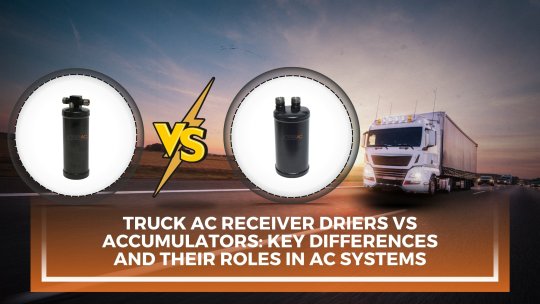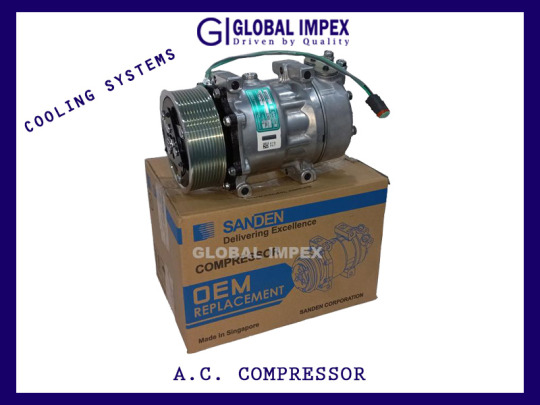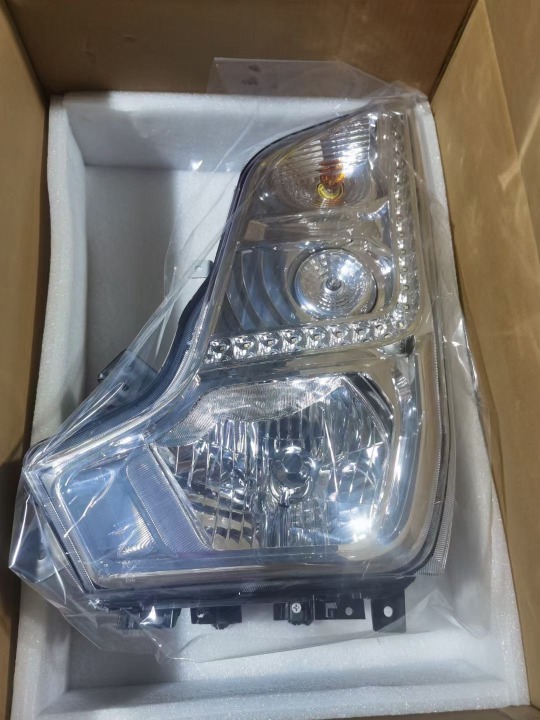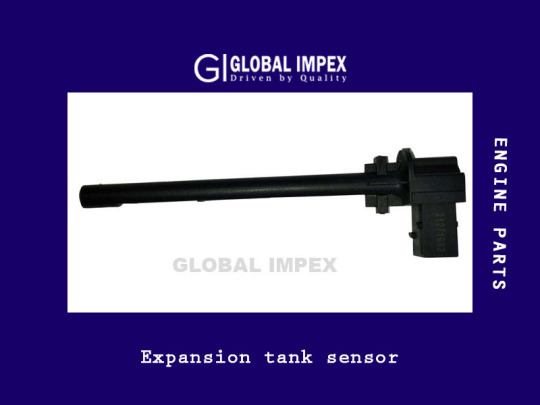#TruckParts
Explore tagged Tumblr posts
Video
turkish_automotive_industry_CeskytT (13) by Barta Silvia Cesky Trucker Via Flickr: www.ceskytrucker.eu
#turkishautomotiveindustry#CESKYTRUCKER#SalesPromotion#SocialNetworks4You#truckspareparts#promoturkishsuppliers#promoturkishmanufacturers#truckparts#automotivemarketing#automotiveparts#spareparts#flickr
1 note
·
View note
Text
Keep Your Suspension Strong with the Hendrickson Pivot Bolt Kit S-24680 🚛🔧

When it comes to heavy-duty vehicles, suspension systems take the brunt of the load. That’s why maintaining their reliability is so important. Enter the Hendrickson Pivot Bolt Kit S-24680—your ultimate solution for enhancing performance, safety, and durability.
💪 Why Choose the Hendrickson Pivot Bolt Kit S-24680? ✔️ Engineered for heavy loads and rough conditions. ✔️ Perfect compatibility with Hendrickson suspension systems like A-21116 and HTS120. ✔️ Includes everything you need: bolts, washers, and nuts. ✔️ Prolongs suspension system lifespan and boosts safety.
Who Can Benefit from This Kit?
Whether you’re driving a semi-truck, operating construction equipment, or managing industrial machinery, the Hendrickson Pivot Bolt Kit S-24680 has you covered. It’s perfect for: 🚜 Agricultural equipment 🚚 Heavy-duty trucks 🏗️ Construction vehicles
Where to Get It?
Upgrade your suspension system today by visiting Clamp Guy.
🔩 Don’t let worn pivot bolts slow you down! Invest in durability, safety, and performance with the Hendrickson Pivot Bolt Kit S-24680. 🌟
0 notes
Text

🎁 Winter Holiday Sale at ProSource Diesel 🎁
Looking for the best deals on diesel truck parts this winter? We've got you covered with limited-time offers to keep your truck performing at its best.
🛒 Shop now: Winter Holiday Sale
0 notes
Text
Why Choose a Japanese Mini Truck for Your Business?
Japanese mini trucks offer great value with their compact design, making them perfect for diverse business tasks. Our blog explains why choosing a japanese mini truck is ideal, highlighting its versatility, cost-efficiency, and reliability, and showing how these trucks excel in various business tasks while providing outstanding value. Visit our website and read now!

0 notes
Text
Impact of Lift Kit on Suzuki Carry's Performance
The Suzuki Carry, renowned for its compact size and utility, has become a popular choice among drivers who value its easy handling and versatility One modification that enthusiasts often consider for their Suzuki Carry is the installation of lift kits. Lift kits are designed to raise the vehicle's ride height, offering several potential benefits and influencing its handling characteristics and overall performance.

Understanding Lift Kits Lift kits typically consist of taller springs, spacers, and extended shocks that elevate the structure of the Suzuki Carry. This alteration can serve various purposes depending on the driver's preferences and intended use of the vehicle:
Increased Ground Clearance: One of the primary reasons for installing a lift kit is to increase ground clearance. This enhancement allows the Suzuki Carry to navigate rough terrain more effectively, such as unpaved roads or off-road trails. It also helps in preventing undercarriage damage from rocks, debris, or uneven surfaces.
Improved Off-Road Capability: With higher ground clearance comes improved off-road capability. A lifted Suzuki Carry can tackle steeper inclines and uneven terrain with greater ease, making it suitable for outdoor adventures or work in challenging environments.
Enhanced Visibility: A lifted stance can improve visibility for the driver, offering a clearer view of the road ahead. This can be particularly beneficial in rural or off-road settings where obstacles may be less predictable.
Read more
0 notes
Text

Borg Rolls Warner Middle East LLC, a trusted name in the commercial vehicle industery joins TradersFind, offering top-quality components. With a wide range of products including brake systems, compressors, cooling systems, engine parts, bearings, and more, we are your one-stop solution for all commercial vehicle needs. Committed to excellence, our products ensure optimal performance and reliability. Explore our catalog today: https://www.tradersfind.com/seller/borg-rolls-warner-middle-east-llc
#borgrollswarner#commercialvehicles#truckparts#autoparts#automotivecomponents#brakesystem#compressors#coolingsystems#engineparts#bearings#qualityproducts#reliablesolutions#Vehiclemaintenance#aftermarketparts#uaebusiness#uaeauto#uaeindustry#dubaitrade#dubaibusiness#abudhabitrade#abudhabibusiness#sharjahbusiness#uaemanufacturing#madeinuae#uaemade#supplychain#b2btrade#tradersfind
1 note
·
View note
Text
Truck AC Receiver Driers vs Accumulators: Key Differences and Their Roles in AC Systems

Truck air conditioning systems play a crucial role in ensuring the comfort and safety of drivers, especially during long hauls and in extreme weather conditions. These systems rely on various components to function efficiently, including receiver driers and accumulators. While both serve similar functions, they have distinct differences that can impact the performance and efficiency of the AC system. Let's delve into the intricacies of these components and uncover their unique roles in automotive air conditioning systems.
Before delving into the specifics of receiver driers and accumulators, it's essential to grasp the basics of truck air conditioning systems. These systems are designed to regulate the temperature and humidity levels inside the vehicle's cabin, providing a comfortable environment for the driver and passengers. A typical truck AC system comprises several components, including compressors, condensers, evaporators, expansion valves, receiver driers, and accumulators.
Role of Receiver Driers
Receiver driers are integral components of truck AC systems, responsible for removing moisture and contaminants from the refrigerant. A receiver drier is typically located between the condenser and the expansion valve. Its primary function is to trap any moisture or debris present in the refrigerant, preventing it from entering the rest of the system.
Moisture is a significant concern in AC systems, as it can lead to corrosion, reduced cooling efficiency, and compressor damage. By removing moisture, receiver driers help maintain the integrity of the system and ensure optimal performance.
Role of Accumulators
Accumulators serve a similar purpose to receiver driers but are designed for different types of AC systems. In truck AC systems, accumulators are commonly used in vehicles with orifice tube systems. Similar to receiver driers, accumulators also remove moisture and contaminants from the refrigerant, but they primarily focus on storing excess refrigerant during low-demand periods and releasing it when needed. This helps regulate pressure within the system, ensuring consistent performance regardless of operating conditions.
Key Differences Between Receiver Driers and Accumulators
Understanding the disparities between receiver driers and accumulators is essential for selecting the right component for your vehicle's AC system.
Design Variances
Receiver driers are typically larger in size and have a sight glass for visual inspection of refrigerant flow, whereas accumulators are smaller and lack a sight glass. Additionally, receiver driers often feature desiccant material to absorb moisture, while accumulators rely on internal baffles for moisture removal.
Moisture Removal Process
Receiver driers utilize desiccant material to absorb moisture from the refrigerant, whereas accumulators rely on internal baffles to separate liquid refrigerant from any remaining vapor, effectively removing moisture.
Operating Pressures
AC receiver driers operate at higher pressures than accumulators due to their placement on the high-pressure side of the AC system. Accumulators, situated on the low-pressure side, experience lower operating pressures.
Placement in AC Systems
Receiver driers are typically installed in systems that utilize thermal expansion valves, whereas accumulators are common in systems employing orifice tubes. The placement of these components within the AC system impacts their functionality and performance.
Performance in Various Climates
Receiver driers are more effective in humid climates, where moisture absorption is crucial for preventing system damage. Accumulators are suitable for dryer climates, where moisture removal is less of a concern.
Impact on AC System Efficiency
Receiver driers and accumulators both play vital roles in maintaining AC system efficiency by removing moisture and contaminants. However, improper selection or maintenance can lead to reduced efficiency and increased wear on system components.
Applications and Suitability
The choice between receiver driers and accumulators depends on various factors, including the specific requirements of the truck's AC system. Receiver driers are ideal for conventional AC setups, providing reliable moisture removal and filtration. On the other hand, accumulators are better suited for systems that require precise pressure regulation and variable speed control.
Maintenance and Replacement
Signs of Malfunction
Signs of a malfunctioning receiver drier or accumulator include reduced cooling performance, strange noises from the AC system, and visible leaks.
Importance of Regular Inspection
Regular inspection and maintenance of the receiver drier and accumulator are essential to ensuring the continued performance and longevity of the AC system.
Replacement Guidelines
Receiver driers and accumulators should be replaced according to the manufacturer's guidelines or if any signs of damage or deterioration are detected during inspection.
Factors Influencing Choices
The selection between receiver driers and accumulators depends on various factors, including climate, system design, and maintenance considerations. In regions with high humidity levels, receiver driers may be preferred for their superior moisture removal capabilities. However, in colder climates, accumulators may be more suitable for storing refrigerant and preventing liquid slugging during startup.
Cost Considerations
When considering receiver driers vs. accumulators, cost is an important factor to weigh. Receiver driers are generally more affordable upfront but may require more frequent replacements due to their limited lifespan. Accumulators, while initially pricier, offer better long-term value and durability.
Conclusion
In conclusion, both the truck AC receiver drier and accumulator are essential components of the truck air conditioner, each serving to remove moisture and contaminants from the refrigerant. While they have similar functions, they differ in design, operation, and suitability for different conditions. When choosing between a receiver drier and an accumulator for your truck, consider factors such as climate, usage, and compatibility to ensure optimal performance and efficiency.
FAQs
1. Are receiver driers and accumulators interchangeable?
No, receiver driers and accumulators serve different functions and are designed for specific applications within automotive AC systems.
2. How often should receiver driers and accumulators be replaced?
Receiver driers and accumulators should be replaced according to the manufacturer's guidelines or if any signs of malfunction are detected during inspection.
3. Can I replace a receiver drier or accumulator myself?
Additionally, improper installation can lead to system leaks or damage, which may result in costly repairs. It is best to consult with a professional to determine the best course of action for replacing receiver driers and accumulators in your specific vehicle.
4. What happens if a receiver drier or accumulator fails?
If a receiver drier or accumulator fails, it can lead to reduced cooling performance, damage to other AC components, and potential leaks within the system.
5. Are there any aftermarket options available for receiver driers and accumulators?
Yes, there are aftermarket receiver driers and accumulators available, but it is essential to ensure compatibility with your vehicle's AC system before purchasing.
0 notes
Text

🚚✨ Explore top-quality SCANIA Truck Cooling Systems Parts at gispares.in! 🛠️ Our A.C. COMPRESSORS ( https://gispares.in/product/a-c-compressor-3/ ) are built to keep your trucks running smoothly. As your trusted wholesaler, we offer unbeatable prices and reliability you can count on. 🌐 Visit our website today and experience excellence in every part!
#SCANIA Truck#global impex#european truck spare parts#india#europeantruckspareparts#distributor#european truck spare parts supplier#gispares#SCANIA#CoolingSystems#ACCompressor#GISpares#Wholesale#TruckParts
0 notes
Text
Truck Headlights
In the realm of trucks, where power, durability, and ruggedness converge, truck headlights stand as more than mere sources of illumination. They are beacons that define the distinctive character of these formidable vehicles, balancing functionality, safety, and design aesthetics. This comprehensive exploration will delve into the nuances of truck headlights specifically tailored for trucks, tracing their evolutionary journey, exploring the diverse types available, delving into cutting-edge technologies, and understanding their indispensable role in the dynamic world of trucks.
The Historical Odyssey of Truck Headlights:The evolution of truck headlights mirrors the broader history of automotive lighting. From the rudimentary glow of early incandescent bulbs, truck headlights have transformed into sophisticated lighting systems that deliver enhanced visibility and safety features.
Halogen Headlights: A Bright Dawn for Trucks:The introduction of halogen headlights marked a significant leap forward in truck lighting. Halogen bulbs, with their tungsten filaments and halogen gas-filled bulbs, provided brighter and more efficient illumination. In the context of trucks, this transition to halogen headlights improved visibility during nighttime driving and adverse weather conditions.
HID (High-Intensity Discharge) Headlights: Unleashing Powerful Illumination:As the quest for more powerful lighting intensified, HID headlights entered the scene. High-Intensity Discharge technology brought forth a luminous and bluish-white light, elevating visibility for trucks navigating diverse terrains. The powerful output of HID headlights made them a favored choice for those seeking superior illumination.
LED Headlights: Revolutionizing the Truck Lighting Landscape:Recent years have witnessed the ascent of Light Emitting Diode (LED) headlights as the pinnacle of truck lighting technology. LEDs offer numerous advantages, including heightened brightness, energy efficiency, and an extended lifespan. Beyond functionality, LED headlights have become synonymous with modern truck design, providing a sleek and contemporary aesthetic.
Types of Truck Headlights: Tailoring Light for Different Needs:
Sealed Beam Headlights: The traditional sealed beam headlights, common in older truck models, were characterized by a single unit housing an integrated filament, reflector, and lens. While less prevalent today, they hold an iconic place in the history of truck design.
Composite Headlights: Composite headlights introduced a more modular design, featuring separate components for the bulb, reflector, and lens. This design allows for easier replacement and customization, catering to the diverse preferences of truck owners.
Projector Headlights: Precision in Lighting: Projector headlights, commonly found in modern truck designs, use a lens to focus the light produced by the bulb, resulting in a more controlled and concentrated beam. This not only enhances visibility but also provides a distinct visual appeal.
Adaptive Headlights for Trucks: Navigating Dynamic Terrains:Trucks encounter a spectrum of driving conditions, from long highway stretches to off-road adventures. Adaptive headlights, capable of adjusting the direction and range of the light beam based on driving conditions, ensure optimal illumination. This technology is particularly valuable for trucks navigating curves, hills, and challenging terrains.
Matrix Headlights: Precision Redefined in Truck Lighting:Taking adaptability to the next level, matrix headlights utilize individually controllable LEDs to adjust the light pattern in real-time. This precision allows for optimal illumination without causing glare for other road users. Matrix headlights represent the zenith of lighting technology, enhancing both safety and aesthetic appeal for trucks.
Aftermarket Truck Headlights: Customizing the Illumination Experience:The truck community is known for its passion for personalization, and aftermarket options for headlights provide a myriad of choices. LED conversion kits, HID retrofitting, and customized headlight assemblies empower truck owners to tailor the illumination experience to match their preferences and the unique character of their trucks.
Regulatory Compliance: Navigating the Legal Landscape for Truck Headlights:While customization offers flexibility, adherence to legal regulations governing headlight modifications is paramount. Compliance with regulations on headlight color, brightness, and beam patterns ensures road safety and prevents unnecessary glare for fellow road users.
The Future of Truck Headlights: Towards Enhanced Connectivity and Efficiency:The road ahead promises exciting developments in truck headlight technology. Integration with Advanced Driver-Assistance Systems (ADAS) is likely to enhance safety features, with automatic high-beam control, adaptive lighting patterns, and communication with other vehicles on the road. Additionally, energy-efficient solutions and smart connectivity features may become more prevalent, contributing to a more connected and informed driving experience.
Conclusion: Guiding the Future with Precision and Power:Truck headlights, meticulously tailored for the robust nature of trucks, have evolved into sophisticated lighting systems that harmonize functionality, safety, and aesthetics. From the early days of modest incandescent bulbs to the brilliance of LED and adaptive technologies, truck headlights have become iconic symbols of power and resilience on the roads. As technology continues to advance, truck owners can anticipate even more innovative solutions that enhance visibility, energy efficiency, and connectivity. Whether cruising on highways or tackling challenging terrains, well-designed and properly illuminated truck headlights ensure a safe, confident, and visually striking journey for drivers and admirers alike.
For detailed information: Truck headlights
0 notes
Text
Torque Parts LLC
Torque Parts LLC was established in 2012 to provide the heavy-duty aftermarket truck parts, focusing on quality, fast shipment, and excellent customer service.
1 note
·
View note
Text
Genuine Truck Spare Parts for Sale
For more information please contact:
Jeffery Zhu
Mobile/WhatsApp: +8618668955646
#engine #truck #bus #engineparts #spareparts #cumminsengine #weichai #yuchai #piston #pistonrings #pisonsleeves #mainbearing #conrodbearing #cylinderkits #enginefilters #oilfilter #dieselfilter #gearbox #turbocharger #pump #wheeldrum #aircleaner #cylinderliner #engineheadgasket





0 notes
Text

ProSource Diesel Winter Holiday Sale
🎄 Winter Holiday Sale Alert! 🎁 ProSource Diesel is bringing the best deals of the season! Stock up on parts for Powerstroke, Cummins, and Duramax. Keep your truck running strong all year. 🛠️
Shop the sale now 👉 ProSource Diesel Winter Holiday Sale
1 note
·
View note
Text
Impact of Lift Kit on Suzuki Carry's Performance
A lift kit can transform the Suzuki Carry into a versatile vehicle, suitable for both urban driving and off-road adventures. The impact of a lift kit on the Suzuki Carry's performance is substantial. By elevating the vehicle's height, a lift kit significantly enhances its capabilities and affects its handling. Our blog highlights the benefits and key considerations when installing lift kits on your Suzuki Carry. Visit our website for complete information!

0 notes
Video
turkish_automotive_industry_CeskytT (1) by Barta Silvia Cesky Trucker Via Flickr: www.ceskytrucker.eu
#turkishautomotiveindustry#CESKYTRUCKER#SalesPromotion#SocialNetworks4You#truckspareparts#promoturkishsuppliers#promoturkishmanufacturers#truckparts#automotivemarketing#automotiveparts#spareparts#flickr
1 note
·
View note
Text
Reasons Why Your Truck's AC Is Not Blowing Cold Air

If you're a truck owner, you know how essential air conditioning can be, especially during scorching summer months. It can be frustrating and uncomfortable when your truck's AC is not blowing cold air as it should. In this article, we'll explore the common reasons behind this issue and provide practical solutions to help you stay cool on the road.
How Does Your Truck's AC System Work?
Your truck's air conditioning (AC) system is a complex arrangement of components designed to provide excellent, comfortable air on the road. Before we explore the specific reasons why your truck air conditioner might not be blowing cold air, let's take a closer look at the essential components that make up this system and how they collaborate to keep you cool:
1. Compressor
The compressor plays a crucial role in the AC system. It's responsible for pressuring the refrigerant, transforming it from a low-pressure gas into a high-pressure gas. This compression process is vital for cooling the air.
2. Condenser
Once the refrigerant is compressed, it flows into the condenser. The condenser is like a heat exchanger, as it releases the heat absorbed from the cabin air into the outside air, allowing the refrigerant to cool down.
3. Evaporator
The cooled refrigerant now moves to the evaporator. This component is located inside the cabin air handler and is responsible for cooling the air before it enters the truck's cabin. It achieves this by evaporating the refrigerant, which absorbs heat from the surrounding air.
4. Refrigerant
Refrigerant is the substance that circulates through the entire AC system, undergoing phase changes from gas to liquid and back again as it absorbs and releases heat. The specific type and amount of refrigerant are critical for efficient cooling.
5. Cabin Air Filter
While not a part of the refrigeration cycle, the cabin air filter is essential for maintaining clean, fresh air inside your truck's cabin. It filters out dust, pollen, and other airborne particles, ensuring the air is clean and comfortable.
It is understanding how these components may arise. When everything functions correctly, these components work harmoniously to provide refreshing, cold air on hot summer days.
However, if your truck's AC is not blowing cold air, it can be attributed to various factors, which we will explore in the following sections. Understanding how each of these components collaborates and knowing their functions will help you diagnose and address AC issues more effectively.
As we delve into the specific reasons behind AC problems, remember that regular maintenance and prompt attention to issues can prevent many of these problems from occurring in the first place. Now, let's move on to the common culprits when your truck's AC is not performing as it should.
8 Reasons Why Truck's AC Is Not Blowing Cold Air & their Solutions
1. Low Refrigerant Levels
Low refrigerant levels are among the most common reasons for blowing warm air from your truck's AC vents. Refrigerant is the lifeblood of your AC system; if it's running low, your AC won't be able to cool the air effectively. This could be due to a leak or improper maintenance.
Solution: The best way to address this issue is to have a professional technician inspect your AC system, identify leaks, and recharge the refrigerant appropriately.
2. Faulty Compressor
The compressor compresses the refrigerant and turns it into a high-pressure gas. If the compressor malfunctions, it can't perform this crucial task, leading to warm air blowing from the vents.
Solution: Replacing a faulty compressor is a complex task best left to experts. Consult a certified mechanic to diagnose and fix compressor issues.
3. Clogged Condenser
The AC condenser is responsible for releasing heat absorbed by the refrigerant. Over time, it can become clogged with debris, hindering its ability to dissipate heat effectively.
Solution: Regularly cleaning the condenser and removing obstructions can help maintain optimal AC performance.
4. Damaged Evaporator
The evaporator is responsible for cooling the air before it enters the cabin. It can't perform this function correctly if it's damaged or blocked, resulting in warm air.
Solution: Replacing a damaged evaporator is a job for a qualified technician. Seek professional assistance if you suspect issues with this component.
5. Electrical Problems
Electrical issues, such as a blown fuse or malfunctioning AC controls, can also lead to warm air blowing from your AC vents.
Solution: Check the fuses and AC controls for any visible issues. If you're uncomfortable with electrical work, consult a mechanic or electrician.
6. Cabin Air Filter
A dirty or clogged cabin air filter can restrict airflow, reducing the cooling capacity of your AC system.
Solution: Regularly replace your cabin air filter to ensure maximum airflow and efficient cooling.
7. Engine Overheating
An overheating engine can indirectly affect your truck's AC performance. When your engine overheats, it puts additional stress on the AC system, making it less effective.
Solution: Keep your engine well-maintained and ensure the cooling system works well.
8. Refrigerant Leak
Refrigerant leaks can be hard to detect but significantly impact your AC's performance over time.
Solution: If you suspect a refrigerant leak, have a professional technician perform a leak detection test and repair any identified issues.
Conclusion
Maintaining a functional truck air conditioner is essential for a comfortable and safe driving experience, especially in hot weather. When your truck's AC is not blowing cold air, it can be due to various factors, ranging from low refrigerant levels to electrical problems. Regular maintenance and prompt, professional assistance can help you address these issues and keep your truck's AC running smoothly.
FAQs
Q1. How often should I recharge the refrigerant in my truck's AC system?
A1. Refrigerant levels should only be recharged when low due to leaks or other issues. It's not a regular maintenance task.
Q2. Can I fix a clogged condenser myself?
A2. While it's possible to clean the condenser, it's recommended to have a professional do it to avoid damaging sensitive components.
Q3. Are there any DIY solutions for fixing a faulty AC compressor?
A3. Repairing or replacing a compressor is a complex task best left to professionals, as it requires specialized tools and expertise.
Q4. Can a dirty cabin air filter cause long-term damage to my AC system?
A4. Yes, a dirty cabin air filter can strain the AC system and potentially lead to more significant issues if not addressed promptly.
Q5. How can I prevent my truck's engine from overheating?
A5. Regular maintenance, including coolant checks and proper engine care, can help prevent engine overheating, indirectly affecting your AC's performance.
For any significant AC issues or if you're unsure about diagnosing and fixing the problem yourself, it's advisable to consult a qualified mechanic for a thorough inspection and repair. Ensure your truck's AC is in top shape for a comfortable and enjoyable journey.
0 notes
Text

Looking for a reliable Volvo truck Expansion Tank Sensor wholesaler? Look no further! Check out Gispares.in for top-quality sensors and more. Your go-to source for all your truck parts needs.
#global impex#european truck spare parts#india#volvo trucks#europeantruckspareparts#distributor#volvo truck spare parts#european truck spare parts supplier#scania#gispares#Wholesaler#TruckParts#VolvoTruck#ExpansionTankSensor
0 notes